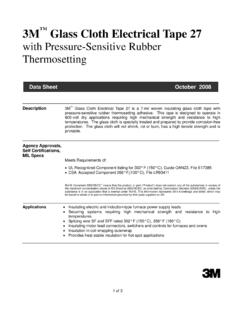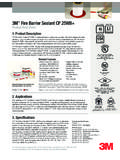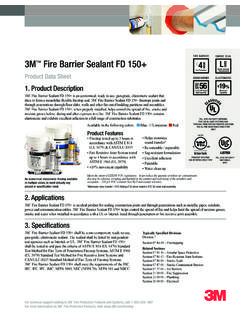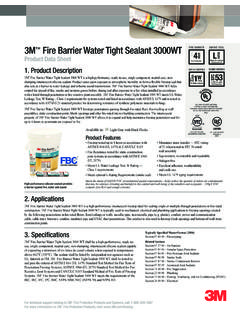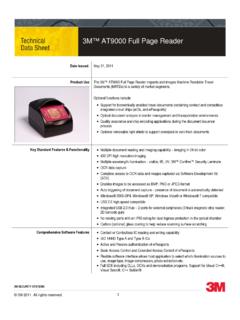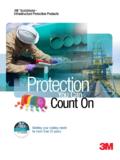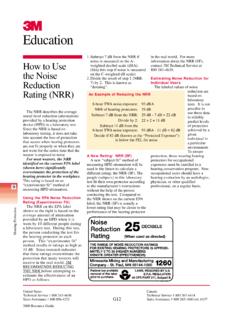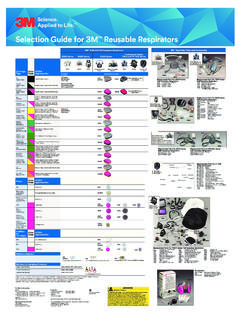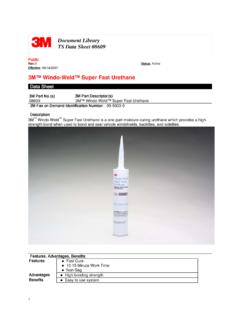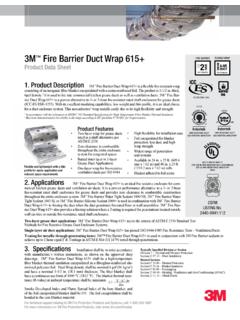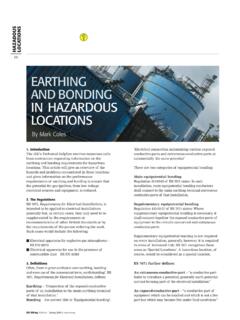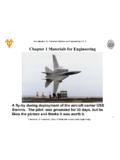Transcription of Neoprene High Performance Contact Adhesive 1357 1357-L
1 3. Neoprene High Performance Contact Adhesive 1357 1357-L . Technical Data September, 2016. Product Description 3M Neoprene High Performance Contact Adhesive 1357 and 1357-L can be used to bond most rubber, cloth, metal, wood, foamed glass, paper honeycomb, decorative plastic laminates and many other substrates. Features Long bonding range. Excellent initial strength. High heat resistance. Typical Physical Note: The following technical information and data should be considered representative Properties or typical only and should not be used for specification purposes. 1357 1357-L .
2 Product Viscosity (approx.): 200-450 cps 35-65 cps Brookfield Viscometer: RVF #2 Sp. RVF #1 Sp. @20 rpm@80 F (27 C) @20 rpm@80 F (27 C). Solids content (by wt.): 23 - 27% 17 - 19%. Base: Polychloroprene Polychloroprene Color: Gray/Green, Light Yellow Gray/Green Net weight (approx.): - - Flash point ( ): -14 F (-26 C) -14 F (-26 C). Solvent: petroleum distillate, petroleum distillate, acetone, MEK, acetone, MEK, toluene, n-hexane toluene, n-hexane Coverage (approx.) 308 219 gms (dry wt.) : Suggested Application Spray, brush, Automatic spray Method(s): roll or flow 3M . Neoprene High Performance Contact Adhesive 1357 1357-L .
3 Handling/Application When bonding wood veneers, success is dependent on many variables such as Information environmental conditions, bonding process, type of base material, type of veneer, Adhesive type and top coat finishing systems to name a few. It is the user's responsibility to thoroughly test any Adhesive for its suitability in bonding wood veneers. It is also recommended to follow the veneer manufacturers recommendation and industry guidelines. Directions For Use: 1. Surface Preparation: Remove all dust, dirt, oil, grease, wax, loose paint, etc. Wiping with solvent such as Methyl Ethyl Ketone (MEK) will aid in preparing the surface for bonding .
4 *. 2. Application Temperature: For best results the temperature of the Adhesive and surfaces to be bonded should be at least 65 F (18 C). If stored below 30 F (-1 C), warm-up to room temperature in a warm room only (do not exceed 120 F (49 C). followed by thorough agitation). 3. Application: Stir or agitate well before using for optimum results. Apply gms to dry weight to each surface. Unusually porous surfaces will require more Adhesive . 4. Drying Time: The Adhesive dries in about 10 minutes. High humidity will slow drying-high temperatures speed the drying. This Adhesive has a bonding range of approximately 30 minutes when applied to both bond surfaces under conditions of 70 F (21 C) and 35% If the Adhesive becomes too dry, apply another thin coat of Adhesive to one surface, allow to become slightly tacky, and bond.
5 Relative humidity above 50% can cause blushing (condensation of moisture on surface) and a false bond. To avoid this, we recommend a force drying temperature of 180-220 F (82-104 C). Force drying will also help remove the solvent more rapidly. 5. Assembly: Spacers, such as dowels or strips of laminate, may be used to help prevent premature Adhesive / Adhesive Contact and bonding prior to positioning. Slide out of the spacers and apply uniform pressure, working toward the edges. A 3 in. roller used with maximum body pressure should be used to help ensure adequate Contact and bonding , especially on edges.
6 The use of a pinch roll is preferred for optimum Performance . Bonded assemblies may be machined, trimmed, etc. immediately after bonding . 6. Cleanup: Adhesive residue of 3M Neoprene High Performance Contact Adhesive 1357 and 1357-L may be removed from exposed surfaces with solvents such as Methyl Ethyl Ketone (MEK), or 3M Citrus Base Industrial Cleaner.*. For flushing fluid lines use MEK. *When using solvents, extinguish all ignition sources, including pilot lights, and follow the manufacturer's precautions and directions for use. -2- 3M . Neoprene High Performance Contact Adhesive 1357 1357-L .
7 Application Equipment Appropriate application equipment can enhance Adhesive Performance . We Suggestions suggest the following application equipment for the user's evaluation in light of the user's particular purpose and method of application. 1. Pumping: A 2:1 divorced design pump is suggested. All material hoses should be nylon or PVA lined. Packings and glands in Contact with the Adhesive should be PTFE. 2. Spray: Air Fluid Air Approximate Air Fluid Spray Applicator Cap Tip Pressure Requirement* Flow**. DeVilbiss JGA, MSA 777 FX 80 psi 181/2 CFM 6 fl. (.042"). Binks No. 95 or 2001 63PH 63 BSS 80 psi 23 CFM 6 fl.
8 (.046"). These adhesives are not recommended for Airless Spraying. *5 Compressor for continuous use. **To Measure Fluid Flow: Pressurize fluid source only; pull trigger, flow material into measuring device for 60 seconds, increase or decrease fluid source pressure to obtain desired fluid flow. 3. Brush/Roller: Typical brushes/rollers designed for oil-based paint may be used. Typical Adhesive Note: The following technical information and data should be considered representative Performance or typical only and should not be used for specification purposes. Characteristics 3M Neoprene High Performance Contact Adhesive 1357 and 1357-L .
9 180 Peel Strength Canvas/Steel Overlap Shear Strength 1/8" Birch/Birch Time Test Value Time Test Value @75 F (24 C) Temp. ( width) @75 F (24 C) Temp. ( ). 1 day 75 F (24 C) 16 after 2 wk. 75 F (24 C) 452. 3 days 75 F (24 C) 31 after 3 wk. 75 F (24 C) 536. 5 days 75 F (24 C) 42 after 3 wk. -30 F (-34 C) 964. 7 days 75 F (24 C) 26 after 3 wk. 180 F (82 C) 199. 2 wk. 75 F (24 C) 24 after 3 wk. 225 F (107 C) 158. 3 wk. 75 F (24 C) 23. after 3 wk. -30 F (-34 C) 13. after 3 wk. 150 F (66 C) after 3 wk. 180 F (82 C) 12. -3- 3M . Neoprene High Performance Contact Adhesive 1357 1357-L .
10 Storage Store product at 60-80 F (16-27 C) for maximum storage life. Higher temperatures can reduce normal storage life. Lower temperatures can cause increased viscosity of a temporary nature. Rotate stock on a first in-first out basis. Shelf Life When stored at the recommended conditions in the original, unopened container, 3M Neoprene High Performance Contact Adhesive 1357 and 1357-L have a shelf life of 15 months. Precautionary Refer to Product Label and Material Safety Data Sheet for health and safety information before using this product. For additional health and safety information, call 1-800-364-3577 or (651) 737-6501.
